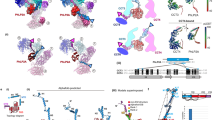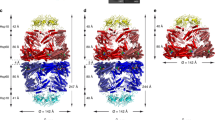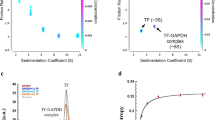Abstract
The chaperonin GroEL is a double-ring structure with a central cavity in each ring that provides an environment for the efficient folding of proteins1,2,3 when capped by the co-chaperone GroES in the presence of adenine nucleotides4,5,6,7,8. Productive folding of the substrate rhodanese has been observed in cis ternary complexes, where GroES and polypeptide are bound to the same ring, formed with either ATP, ADP or non-hydrolysable ATP analogues2,9, suggesting that the specific requirement for ATP is confined to an action in the trans ring that evicts GroES and polypeptide from the cis side9. We show here, however, that for the folding of malate dehydrogenase and Rubisco there is also an absolute requirement for ATP in the cis ring, as ADP and AMP-PNP are unable to promote folding. We investigated the specific roles of binding and hydrolysis of ATP in the cis and trans rings using mutant forms of GroEL that bind ATP but are defective in its hydrolysis. Binding of ATP and GroES in cis initiated productive folding inside a highly stable GroEL–ATP–GroES complex. To discharge GroES and polypeptide, ATP hydrolysis in the cis ring was required to form a GroEL–ADP–GroES complex with decreased stability, priming the cis complex for release by ATP binding (without hydrolysis) in the trans ring. These observations offer an explanation of why GroEL functions as a double-ring complex.
This is a preview of subscription content, access via your institution
Access options
Subscribe to this journal
Receive 51 print issues and online access
$199.00 per year
only $3.90 per issue
Buy this article
- Purchase on Springer Link
- Instant access to full article PDF
Prices may be subject to local taxes which are calculated during checkout













Similar content being viewed by others
References
Weissman, J. S.et al. Mechanism of GroEL action: productive release of polypeptide from a sequestered position under GroES. Cell 83, 577–588 (1995).
Weissman, J. S., Rye, H. S., Fenton, W. A., Beechem, J. M. & Horwich, A. L. Characterization of the active intermediate of a GroEL-GroES-mediated protein folding reaction. Cell 84, 481–490 (1996).
Mayhew, M.et al. Protein folding in the central cavity of the GroEL–GroES chaperonin complex. Nature 379, 420–426 (1996).
Chandrasekhar, G. N., Tilly, K., Woolford, C., Hendrix, R. & Georgopoulos, C. Purification and properties of the GroES morphogenetic protein of Escherichia coli. J. Biol. Chem. 261, 12414–12419 (1986).
Jackson, G. S.et al. Binding and hydrolysis of nucleotides in the chaperonin catalytic cycle: implications for the mechanism of assisted protein folding. Biochemistry 32, 2554–2563 (1993).
Todd, M. J., Viitanen, P. & Lorimer, G. H. Dynamics of the chaperonin ATPase cycle: implications for facilitated protein folding. Science 265, 659–666 (1994).
Burston, S. G., Ranson, N. A. & Clarke, A. R. The origins and consequences of asymmetry in the chaperonin reaction cycle. J. Mol. Biol. 249, 138–152 (1995).
Hayer-Hartl, M., Martin, J. & Hartl, F.-U. Asymmetrical interaction of GroEL and GroES in the ATPase cycle of assisted protein folding. Science 269, 836–841 (1995).
Hayer-Hartl, M. K., Weber, F. & Hartl, F.-U. Mechanism of chaperonin action: GroES binding and release can drive GroEL-mediated protein folding in the absence of ATP hydrolysis. EMBO J. 15, 6111–6121 (1996).
Goloubinoff, P., Christeller, J. T., Gatenby, A. A. & Lorimer, G. H. Reconstitution of active dimeric ribulose bisphosphate carboxylase from an unfolded state depends on two chaperonin proteins and Mg-ATP. Nature 342, 884–889 (1989).
Todd, M. J., Lorimer, G. H. & Thirumalai, D. Chaperonin-facilitated protein folding: Optimization ofrate and yield by an iterative annealing mechanism. Proc. Natl Acad. Sci. USA 93, 4030–4035 (1996).
Ranson, N. A., Dunster, N. J., Burston, S. G. & Clarke, A. R. Chaperonins can catalyze the reversal of early aggregation steps when a protein misfolds. J. Mol. Biol. 250, 581–586 (1995).
Peralta, D., Hartman, D. J., Hoogenraad, N. J. & Hoj, P. B. Generation of a stable folding intermediate which can be rescued by the chaperonins GroEL and GroES. FEBS Lett. 339, 45–49 (1994).
Ranson, N. A., Burston, S. G. & Clarke, A. R. Binding, encapsulation and ejection: substrate dynamics during a chaperonin-assisted folding reaction. J. Mol. Biol. 266, 656–664 (1997).
Weissman, J. S., Kashi, Y., Fenton, W. A. & Horwich, A. L. GroEL-mediated protein folding proceeds by multiple rounds of binding and release of nonnative forms. Cell 78, 693–702 (1994).
Otto, M. R., Lillo, M. P. & Beechem, J. M. Resolution of multiphasic reactions by the combination of fluorescence total-intensity and anisotropy stopped-flow kinetic experiments. Biophys. J. 67, 2511–2521 (1994).
Beechem, J. M., Sherman, M. A. & Mas, M. T. Sequential domain unfolding in phosphoglycerate kinase: fluorescence intensity and anisotropy stopped-flow kinetics of several tryptophan mutants. Biochemistry 34, 13943–13948 (1995).
Etfink, M. R. The use of fluorescence methods to monitor unfolding transitions in proteins. Biophys. J. 66, 482–501 (1994).
Xu, Z., Horwich, A. L. & Sigler, P. B. The crystal structure of the asymmetric GroEL–GroES–(ADP)7chaperonin complex. Nature 388, 741–750 (1997).
Roseman, A. M., Chen, S., White, H., Braig, K. & Saibil, H. R. The chaperonin ATPase cycle: mechanism of allosteric switching and movements of substrate-binding domains in GroEL. Cell 87, 241–251 (1996).
Burston, S. G., Weissman, J. S., Farr, G. W., Fenton, W. A. & Horwich, A. L. Release of both native and non-native proteins from a cis-only GroEL ternary complex. Nature 383, 96–99 (1996).
Pierce, J. & Reddy, G. S. The sites for catalysis and activation of ribulosebisphosphate carboxylase share a common domain. Arch. Biochem. Biophys. 245, 483–493 (1986).
Hartl, F. U. Molecular chaperones in cellular protein folding. Nature 381, 571–579 (1996).
Fenton, W. A. & Horwich, A. L. GroEL-mediated protein folding. Protein Sci. 6, 743–760 (1997).
Acknowledgements
We thank K. Furtak and J. Sutin for technical assistance, and D. Boisvert for discussion. This work was supported by grants from the NIH. S.G.B. is a fellow of the Wellcome Trust.
Author information
Authors and Affiliations
Author notes
Correspondence and requests for materials should be addressed to A.L.H.
Rights and permissions
About this article
Cite this article
Rye, H., Burston, S., Fenton, W. et al. Distinct actions of cis and trans ATP within the double ring of the chaperonin GroEL. Nature 388, 792–798 (1997). https://doi.org/10.1038/42047
Received:
Accepted:
Issue Date:
DOI: https://doi.org/10.1038/42047
This article is cited by
-
Crystal structure of P. falciparum Cpn60 bound to ATP reveals an open dynamic conformation before substrate binding
Scientific Reports (2021)
-
Heat shock proteins with an emphasis on HSP 60
Molecular Biology Reports (2021)
-
Structural basis for active single and double ring complexes in human mitochondrial Hsp60-Hsp10 chaperonin
Nature Communications (2020)
-
A distributive peptide cyclase processes multiple microviridin core peptides within a single polypeptide substrate
Nature Communications (2018)
-
The versatile mutational “repertoire” of Escherichia coli GroEL, a multidomain chaperonin nanomachine
Biophysical Reviews (2018)
Comments
By submitting a comment you agree to abide by our Terms and Community Guidelines. If you find something abusive or that does not comply with our terms or guidelines please flag it as inappropriate.



